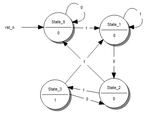hobbyiclearner
Full Member level 2
Hi,
I wanted to know which is a better method of inputting FSMs in Xilinx; the manual way or through statecad. I am asking this as I noticed that statecad was discontinued from ISE 11. This made me suspicious as to which is the better way. BTW, is there any statecad equivalent in vivado. Also what is its equivalence in Altera. I basically prefer the graphical way rather than typing out the various cases of the FSM.
Thanks and Regards,
Hobbyiclearner.
I wanted to know which is a better method of inputting FSMs in Xilinx; the manual way or through statecad. I am asking this as I noticed that statecad was discontinued from ISE 11. This made me suspicious as to which is the better way. BTW, is there any statecad equivalent in vivado. Also what is its equivalence in Altera. I basically prefer the graphical way rather than typing out the various cases of the FSM.
Thanks and Regards,
Hobbyiclearner.
